New Hampshire is a state in the northeastern region of the United States and has many stunning mountains and forests. With more than 500 native animals, it’s very likely that you’ll see some fascinating wildlife if you’re out exploring – including snakes. There are eleven species of snakes in New Hampshire, but only one of them is venomous. Identifying snakes can be tricky sometimes, so join us as we discover the black snakes in New Hampshire.
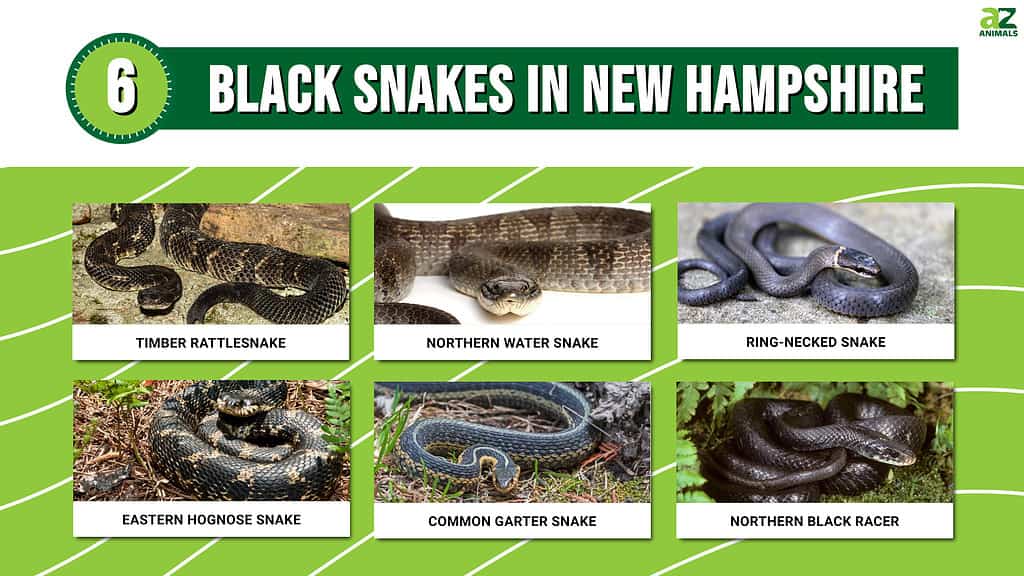
1. Timber Rattlesnake (Crotalus horridus)
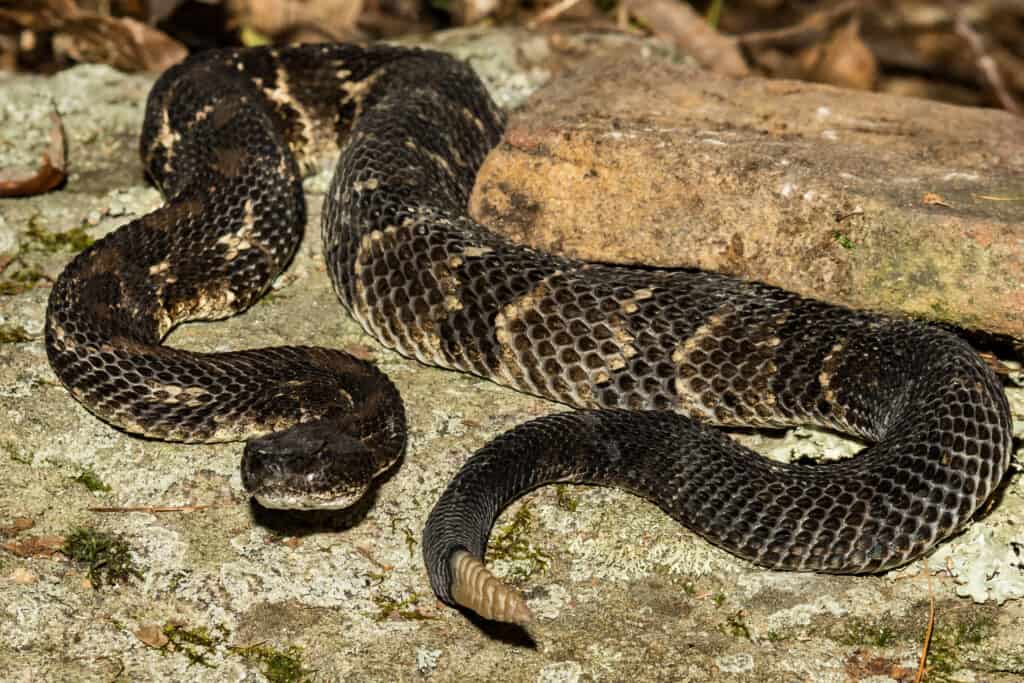
Timber
rattlesnakes
live in forests and on rocky hillsides along only the southern edge of the state.
©iStock.com/JasonOndreicka
We begin our list with the only venomous snake in New Hampshire – the timber rattlesnake. Timber rattlesnakes reach approximately 60 inches long and typically have dark brown bodies with black crossbands. However, although this is their main color, there are also “black phase” timber rattlesnakes. Black phase snakes have a very dark brown to black ground color with even darker crossbands. In many cases, black phase timber rattlesnakes appear to be entirely black. Interestingly, most of the timber rattlesnakes in New Hampshire are actually black phase.
Timber rattlesnakes live in forests and on rocky hillsides along only the southern edge of the state. Although they were once more common, timber rattlesnakes are now a critically endangered species in the state. In fact, they are so rare that there is only one small group of them left! This means that it is very unlikely that you will see them in New Hampshire at all. However, these snakes are highly venomous, although this is counter-acted by their fairly mild temperament.
2. Northern Water Snake (Nerodia sipedon)
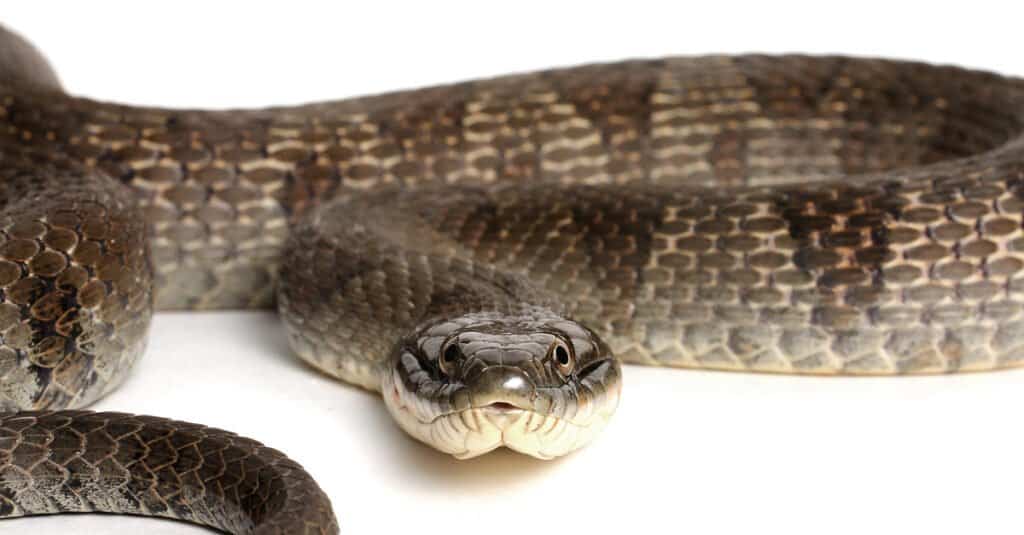
Northern water snakes rarely stray far from water and can be found in many wetland areas – such as rivers, streams, swamps, and ponds.
©Michiel de Wit/Shutterstock.com
Another black snake in New Hampshire is the northern water snake which is a large snake that reaches 24 to 42 inches long. They have dark brown – sometimes black – bodies and dark crossbands. In other states, they are often mistaken for the venomous cottonmouth snake (which is absent from New Hampshire). These snakes are fairly widespread across the state, although they are absent from most northern counties. Northern water snakes rarely stray far from water and can be found in many wetland areas – such as rivers, streams, swamps, and ponds. Quite often, they can be found basking near the water’s edge, although they are quick to flee back into the safety of the water if they are disturbed.
Northern water snakes are not venomous but can be aggressive and readily bite if handled. They rely on water for their prey, and their diet mainly consists of fish and frogs. Although their population is currently secure in New Hampshire, their biggest threat comes from habitat loss and the resulting loss of prey animals.
3. Ring-Necked Snake (Diadophis punctatus)
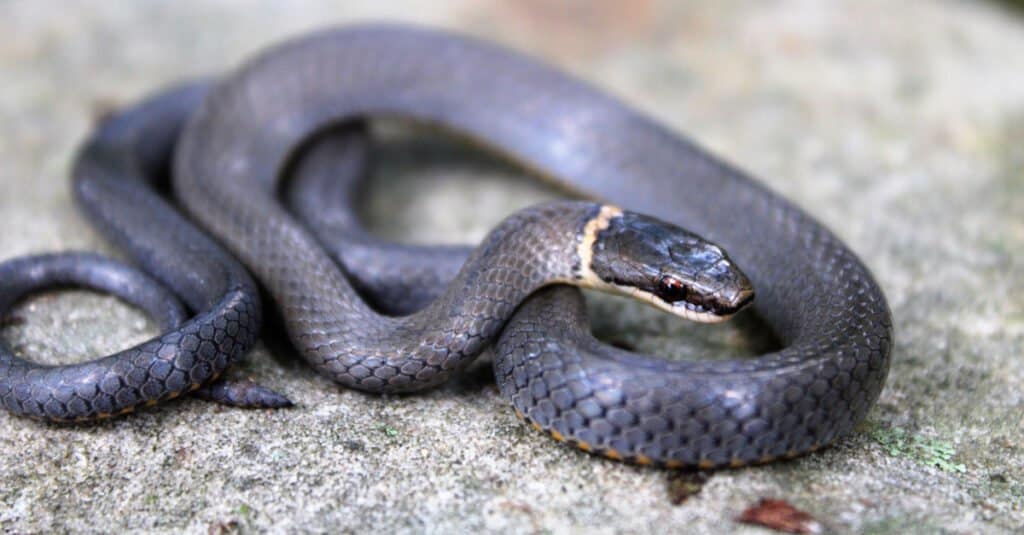
Ring-necked snakes are not venomous to humans, but they produce a mild type of venom they use to kill their prey.
©Tucker Heptinstall/Shutterstock.com
The smallest snake on the list is the ring-necked snake. These snakes have a distinctive appearance but are rarely seen as they are nocturnal, shy, and secretive. Ring-necked snakes are 10 to 20 inches long and have black or greyish-black bodies with a ring of color around their neck. The northern ring-necked snake is the subspecies that is most commonly found in New Hampshire and has a golden yellow to orange neck ring and a belly that is the same color. Other subspecies can have a red belly and neck ring.
Ring-necked snakes are found across the entire state, where they live in moist woodlands and forested hillsides. They typically spend most of their time hidden away in the leaf litter or underneath rocks and logs. Ring-necked snakes are not venomous to humans, but they produce a mild type of venom that they use to kill their prey. Their diet mainly consists of salamanders, worms, and slugs. As these snakes are so small, they are frequently preyed on by animals such as frogs, toads, birds, and small mammals.
4. Eastern Hognose Snake (Heterodon platirhinos)
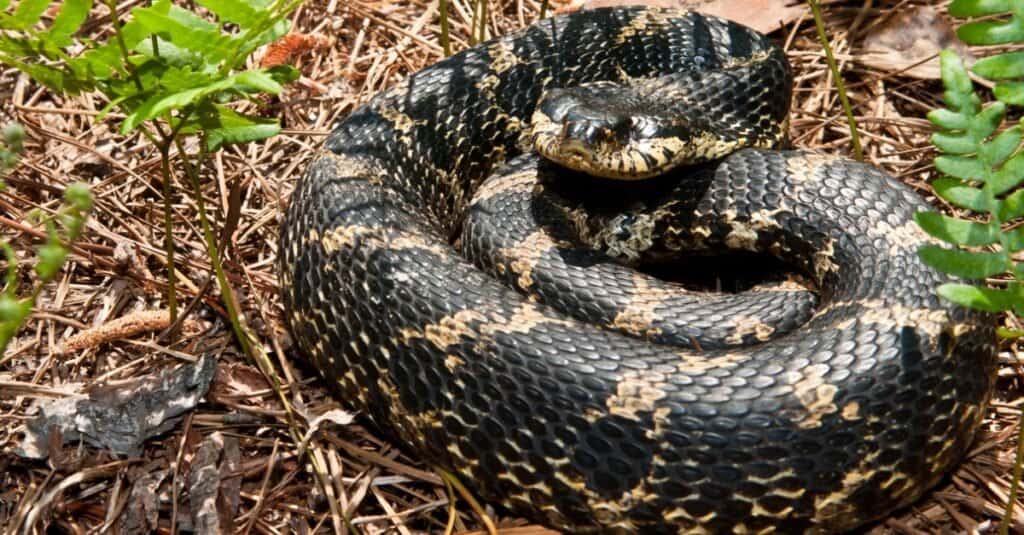
Eastern hognose snakes are 20 to 33 inches long and can have red, black, grey, or brown bodies with dark brown to black blotches.
©iStock.com/JasonOndreicka
Another endangered snake in New Hampshire is the eastern hognose snake which has a limited range in the state. Eastern hognose snakes are only found in the southern region of New Hampshire from Concord county to the Massachusetts border along the Merrimack River in areas with loose, sandy soil. Their biggest threats come from habitat loss and from people mistaking them for venomous snakes and killing them.
Eastern hognose snakes are 20 to 33 inches long and can have red, black, grey, or brown bodies with dark brown to black blotches. “Black phase” snakes can also be found, which are almost entirely greyish black. The most distinctive feature of eastern hognose snakes is their upturned snout. When they are threatened, they flatten their neck and hiss violently, which is why they can be mistaken for a venomous snakes. It is also the reason that they are nicknamed “spreading adders.” Despite this, they are not dangerous to humans.
5. Common Garter Snake (Thamnophis sirtalis)

Common garter snakes are slightly venomous to their prey but are not truly venomous or dangerous to humans.
©iStock.com/Wildnerdpix
The common garter snake is one of the most widespread snakes in New Hampshire and is found statewide and lives in a variety of habitats. However, their preferred habitats are grasslands, forests, and wetlands. Although they can grow longer, most garter snakes are 18 to 26 inches long. Their appearance varies as they can be black, brown, or even green, with three yellow or cream stripes along their back and either side of their body.
Common garter snakes are slightly venomous to their prey but are not truly venomous or dangerous to humans. Any bite from these snakes typically only results in localized itching or swelling. However, a fascinating thing about these snakes is that they are immune to the poison produced by toads – which is just as well since they’re one of their favorite meals!
6. Northern Black Racer (Coluber constrictor constrictor)
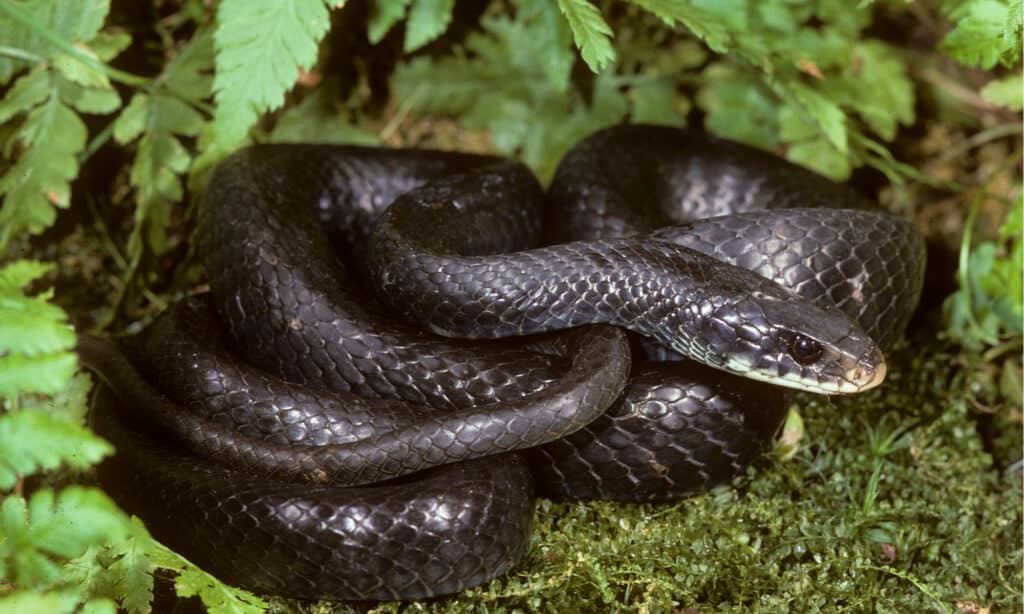
Northern black racers have slender, black bodies with smooth scales, which gives them a glossy appearance.
©Breck P. Kent/Shutterstock.com
The last black snake in New Hampshire is the northern black racer. These snakes are a subspecies of the eastern racer. They are a threatened species in the state and are only sparsely distributed across the southeastern region, where they live mainly in woodlands and grasslands. Northern black racers are large snakes, reaching 36 to 60 inches long. They have slender, black bodies with smooth scales, which gives them a glossy appearance. Additionally, they have distinctive white markings on their chin, throat, and lips.
As their name suggests, northern black racers are quick, agile snakes, and they prey on a wide range of birds, reptiles, amphibians, small mammals, and even other snakes. Although it is often thought that they are constrictors, they do not actually truly kill by constriction. In most cases, they simply overpower their prey before swallowing it alive.
Summary of 6 Black Snakes in New Hamphire
| Name | Length in inches | Diet |
|---|---|---|
| Timber Rattlesnake | Up to 60 | Rabbits, squirrels, rats, mice, and occasionally birds, other snakes, lizards, and frogs. |
| Northern Water Snake | 24-42 | Fish and frogs. |
| Ring-necked Snake | 10-20 | Salamanders, worms, and slugs, |
| Eastern Hognose Snake | 20-33 | Primarily toads, but also frogs, salamanders, small mammals. |
| Common Garter Snake | 18-26 | Frogs, toads, small mammals, earthworms and insects. |
| Northern Black Racer | 36-60 | Birds, reptiles, amphibians, small mammals, and other snakes. |
The photo featured at the top of this post is © iStock.com/mynewturtle
Discover the "Monster" Snake 5X Bigger than an Anaconda
Every day A-Z Animals sends out some of the most incredible facts in the world from our free newsletter. Want to discover the 10 most beautiful snakes in the world, a "snake island" where you're never more than 3 feet from danger, or a "monster" snake 5X larger than an anaconda? Then sign up right now and you'll start receiving our daily newsletter absolutely free.
Sources
- New Hampshire Fish and Game Department, Available here: https://www.wildlife.state.nh.us/wildlife/profiles/black-racer-snake.html
- New Hampshire Fish and Game Department, Available here: https://www.wildlife.state.nh.us/wildlife/profiles/garter-snake.html
- New Hampshire Fish and Game Department, Available here: https://www.wildlife.state.nh.us/wildlife/profiles/hognose-snake.html
- New Hampshire Fish and Game Department, Available here: https://www.wildlife.state.nh.us/wildlife/profiles/water-snake.html
- New Hampshire Fish and Game Department, Available here: https://www.wildlife.state.nh.us/wildlife/profiles/ringneck-snake.html
- New Hampshire Fish and Game Department, Available here: https://www.wildlife.state.nh.us/wildlife/profiles/timber-rattlesnake.html
Thank you for reading! Have some feedback for us? Contact the AZ Animals editorial team.






